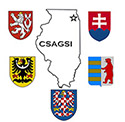Chicago Sokols
In the Summer 2001 issue of the Journal Koreny, editor Paul Nemecek published this article on sokols in Chicago. “The History of the Czech American Sokol of Chicago”, translated by Robert O. Uher:
The Czech-American Sokol of Chicago was founded on April 5, 1868 in the hall of Frank Vilim on the comer of Canal and Taylor streets where the group met until their own hall was built in 1869. In that place on that day a constituting group of brothers formed this new Sokol, they were: Frank Bedlan, Adolf Chladek, Vojtech Klimes, Frank 'Vilim, Vaclav Ledvinka, Frank Kaspar, Frank Nemec, Matej Patera, Vaclav Morava, Eduard Uhlif, Jakub Hrodej, John Kolar, Matej Pisa, John Benes, Josef Fucik, Josef Hladovec, Josef Pugner, Josef Koberna, John Smidt. Anton Lahoda" first secretary, Matej Kristufek, first instructor, Frank Legro, Tomas Kalas, F. J. Haut, K. Sladek, John Urban, Bletislav Kubicek, Vinc Wiesner, Frank Landa. Frank Dohnal, W. Steinberger, Jiri Drobny, Vaclav Laitner, John Engelthaler, Vaclav Pilat. Josef Kopta , Moric Sisland, Matej Venecek, Josef Rothbauer, Vaclav Smolik. Josef Smolik, John Houdek and Matej Blaha. Of these charter members, Tomas Kalas, Frank Legro and Karel Sladek are alive today (1934). In 1869 the Czech-American Sokol built their one story meeting hall at 106-108 (now 515-517) DeKoven Street at a cost of $7146. Additional stories were added in 1882 at a cost of $8500. The ground floor contained a gymnasium which extended to the length and width of the building and a store room. The second floor contained both a lodge room and a room for refreshments. The third floor contained a spacious hall with a stage. The building was used for gymnastics training, lodge meetings, dramatic presentations. Sokol events, and public gymnastic exhibitions.
For a number of years this group was at the forefront of American Sokols. In the year 1874 they hosted a public gymnastic tournament with a prize of $300. Contestants were Frank Vinicky, the best gymnast from the Gymnastic Union of New York and Chicago brothers Stephen, Tomas and John Bilek and Matej Kristufek. The judges of this contest were members of the German Turners Association. Victory was claimed by brother Tomas Bilek.
In 1880 brother Tomas Bilek arranged a gymnastic exhibition at Coulter's Opera House in Aurora. Illinois. According to journals the event was magnificent and though being a locally unknown activity the Opera House was filled to the last seat. In 1878 under the initiative of brother Josef Matejka a National Sokol Union was created composed of 13 Sokol Unions, The first Congress of this group met at Chicago in August 1878. In Chicago at this time there existed only two Sokol groups, the Czech-American and the Telocvicna Jednota Sokol (the first Chicago Sokol), At this Congress it was decided to have the same blue uniform, a dress requirement which continues to the present day.
In 1879 the first Sokol gathering and championship exercises were held in New York. To this were sent brothers Dr. Frank Patera, Josef Pisa, Tomas Bilek, Jolm Bilek and Alois Kreml. Brother Pisa won first prize and four other individual prizes. The other brothers also won prizes for their performances.
The second Sokol Congress was held in Detroit, Michigan in 1881. The Czech-American Sokol was represented by Dr. F. Patera, Jos. Pisa, Mat. Krisrufek, Stephen Bilek, Adolf Bilek and Theodore Vavrinek. The first prize was won by brother Dr. Patera. In 1887 the Czech-American Sokol participated in an excursion to Praha for the Second Sokol Slet held there. Tournaments were held in Cesky Brod where our Sokol was represented by Dr. F. Patera, August Patera, Josef Pisa and Tomas Nadr. Around this time there also was an American Sokol Slet held in New York, In addition to those named above, brothers Adolf Bilek, Jos. Krejca and Theo. Vavrinek participated, These brothers gained a number of prizes in New York as well as in Praha. In 1888 our group participated at a Sokol Slet in St. Louis, Mo. sending a team which won first prize.
A Sokol Slet and championship exercises were held ill 1891 in Milwaukee where two teams won a total of 32 prizes. Oil July 6, 1892 the Czech- American Sokol merged with the Telocvicna Jednota Sokol and then operated under a new name, Sokol Slovanska Lipa. In December of that year the Chicago Atheneum arranged a great exercise with prizes in the Auditorium Theater at Congres and Michigan Avenues in which other nationality groups also participated. The Slovanska Lipa Sokol gained six prizes.
In connection with the 1893 World's Fair a Sokol Slet was arranged in the 2nd Regiment Armory at Washington and Curtis streets. Our team was entered in two divisions where they received first prize and oilier individual awards. The Slovanska Lipa group later joined the Telocviena Jednota Sokol Tabor but when the joining was made public it was disliked by the former members of the Czech-American Sokol and in 1896 they again separated and the Czech-American Sokol was re-established. In 1902 our group numbered over 100 persons. The group rented space in the building of the C.S.P.S. school on 18th street where for the deposit of $100 they became members of the building association. Here they also started a women's Sokol group which functioned separately. In November 1907 with the help of Dr. Ant. Mueller and his wife an academy was set up. This worked out wonderfully because it was awaited by the public and a gymnastic exhibition was held the following year. This exercise included our Sokol veteran, brother Matej Kristufek, the original instructor in 1874 who still carried out his part in 1908.
In the year 1917 when our United States entered the World War sixteen of our young brothers entered the military service. Of these only one brother, John Kahoun returned to the Sokol. The interest of the others slackened and they did not return to Sokol activities. That was the first blow to a disturbed Sokol life. Training did continue but deaths of the older brothers and apathy toward the payment of dues caused more misfortune. In the final years, economic crisis and financial calamity closed in on the formerly famous Czech-American Sokol so that only 16 regular members remained. However at this worst time, in the fall of 1933, a miracle occurred and a number of young men who were former members of various Sokol Unions decided it was necessary in Czech Pilsen, a former bastion of Czech life, to pull together and found a new Sokol Union which they named "American Sokol". These sixteen members were accepted into the Union and entered as founding members. This action ended the great as well as sad epoch of the Czech- American Sokol.
Translator's notes:
1.) The sources for this article were Kvety Americke, July 6, 1887 article "Hall of the Czech-American Sokol ill Chicago, IL and the 1934 publication "From the History of the Czech- American Sokol - According to the Recollections of Brother Theodore Vavrik". 2) The first Sokol Union in Chicago was founded August 1, 1866 ill the first hall of the Slovanska Lipa at Clinton and Van Buren Streets. The first officers were Frank Novak, Chairman, Jan Kalal, Deputy, F. Krch, Bookkeeper, Anton Jurka, Secretary, Adolf Chladek, Leader, Josef Uher (my grandfather] First Instructor, Josef Kabrna, Second Instructor, and Josef Potemesil, Flag Bearer. It was named "Telocvicna Jednota Sokol" (Gymnastic Society Union). The first Slovanska Lipa Hall burned in 1867 and a new one was built in 1869 on Taylor Street between Canal and Beach Street (one block east of Canal]. At this time, due to a disagreement, the members named at the beginning of this article did secede and form the new Sokol Union which they named the Czech-American Sokol. They built their own hall on DeKoven Street as named earlier. The full history is described above.”
Additional Information Found
Svornost – August 12, 1878 – “Sokols Meet”
Yesterday was a day of celebration for Chicago Bohemians because of the convention of National Gymnastic Societies. Both Local Societies the "Cesko Americkeho Sokola" (Bohemian American Sokols) and the "Telocvicne Jednoty Sokol" (Gymnastic Union Sokol) took part in the ceremonies. Both halls of these societies were filled to capacity. The celebration came to a close in the evening in Gymnastic Union Hall where the historic play "Zebraci"(Beggars) was given with great success. The celebration ended in good order to the satisfaction of all and indicated to us how such occasions can be carried out successfully when all work in harmony.
It is expected that yesterday's celebration will be the means of bringing about more friendly relations between our local gymnastic societies.
Svornost – April 24, 1879 – “The Bohemian Sokols”
That friends of the Sokol movement in Chicago have not diminished in numbers is but proven by the fact that since the organization of the National Sokol Union, both of our older local units the "Telocvicne Jednota Sokol" (Gymnastic Union Sokol) and the "Cesko-Americke Sokol" (Bohemian-American Sokol) have added many new and active members. Also there has been organized a new unit of Sokols on the Northwest Side known as "Cechie" (Bohemians) which already has quite a large membership.
On all sides the movement is being ardently carried on, but even so it is not as strong as should be expected from close to 25,000 Bohemians. Our youth, who should seek not only entertainment, but as one of their foremost requirements the acquisition of a healthy body and mind through Physical Culture, remain away to the detriment of both the movement and themselves. No youth who cares about a healthy body and decent entertainment should remain away from this organization, but should at the earliest possible opportunity become a member thereof.
Svornost – July 7, 1892 – “The Slovak "Lipa." Bohemian American Sokol and Gymnasium Union Sokol Unite.”
The union of the Gymnastic Union and Bohemian American Sokols, two of the oldest Sokol bodies in the city became a reality yesterday, and today we have but one strong body, the Sokol "Slovak Lipa," which will hold its meetings and gymnastic drills in the hall on DeKoven St.
The members of both clubs met last night in their respective halls for final meetings, at which were read minutes from the previous meeting. When Bohemian American Sokol had attended to these formalities, it lined up and marched to the Gymnastic Union Sokol Hall where Lawyer Kohout read the terms of the union and of the new charter.
The Bohemian American Sokol numbered 156 members and the Gymnastic Union Sokol numbered 193 members, therefore, the Sokol "Slovak Lipa" numbering 349 members is one of the strongest Sokol Unions in America.
Denni Hlasatel – May 22, 1911 – Slovanska Lipa A Brief Summary of the History of an Old Sokol Society
Toward the end of the year 1901, Sokol Slovanska Lipa was on the decline, and it was thought that this society would vanish entirely. The reason for this was that Bohemians were rapidly leaving DeKoven Street, and seeking a new center for themselves in Bohemian California, on 18th Street. The reasons which lead to the disintegration of the Slovanska Lipa are diverse.
The chief reason was that the members were not allowed to cultivate athletics, although the majority endeavored to do so. To this, however, the president of the society, Mr. Vaclav Zahrobsy, the commander, Mr. Flor. Holek, and other older members, did not want to agree. The result of this was that the membership began to leave the Slovanska Lipa and join other societies. Because Slovanska Lipa did not have enough members, training was discontinued, and no younger members were accepted. The homes on DeKoven Street which were abandoned by the Bohemians, were occupied by Italians, who live there to this date. Time went fast, and little by little Slovanska Lipa would have been forgotten.
However, being moved by an inward instinct, the former leaders of Slovanska Lipa began work to again revive it. They succeeded, after several meetings in acquiring a young membership, and a new instructor, Mr. Joseph Petr, was engaged, who again brought everything back to the old order, after a dormant period of eight years.
Mr. Petr is instructing eight adult members, six members over fourteen years of age, and twenty-five female sokols. Slovanska Lipa now has a total of 190 members. It is progressing forward with a will, and sponsors entertainments and educational lectures. This society is again working with new strength and vigor toward the indicated goal. A brief review of the history of Slovanska Lipa, which we bring here, will surely interest every reader of this paper.
Sokol Slovanska Lipa from 1865 to 1870
Sokol Slovanska Lipa, otherwise formerly called "Janet" (Unity), was created from "Cesko-Americky Sokol" (Bohemian-American Sokol). Sokol also was a branch of this unity, and used the insignia and attire of the original Sokol of Prague. Because of diverse opinions about attire and gymnastic matters, part of the society organized into an independent society, Cesko-Americky Sokol, after which all such societies had their own administrations. May 5, 1868 was the day of dissolution. The origin of the first society of the Slovanska Lipa cannot be given definitely for in the oldest minute books available, those of March 2, 1865, the officers of the society already had been elected.
At that time, the societies were regularly managed, and books kept. Sick benefits were being paid and records of receipts, disbursements, and minutes of meetings kept. Libraries were established and books loaned.
From observation, it appears that each branch belonging to the unity had its own management and library. The president of the society communicated a password to each member, without which the member was not permitted to attend the meeting of the Slovanska Lipa.
It is also remembered that the Bohemian school at that time was managed by four members, and the school children were accepted for training. Bohemian plays were given, such as "chytrousek," "Prazsky, Flamendr" and others. On the day when President Abraham Lincoln was assassinated, merriment and training was postponed, and preparation begun for the attendance of Slovanska Lipa at the funeral. On April 17, 1865, the Bohemian public was invited to a general gathering in the hall of Slovanska Lipa, so as to collectively express their grief over the loss of the President. Bohemian girls were requested to decorate the hall in a suitable manner.
With the arrival of a more educated class of Bohemians in America, the membership of Slovanska Lipa increased visibly. Additional books were bought, and a library established, which was complete for that period. Public gymnastic exhibitions were given, and evening dances were given in a hall especially rented for the purpose.
The by-laws of the Slovanska Lipa in the year 1870 were as follows::
(1) To cultivate and maintain the Bohemian nationality.
(2) To endeavor to establish and maintain a Bohemian-English liberal school.
(3) To cultivate dramatic art through Czech-Slavonic songs.
(4) To maintain libraries and public reading rooms.
(5) To cultivate physical culture.
(6) To give assistance in case of sickness and accident.
The Manner in Which Members Were Accepted Into the Slovanska Lipa
Members were classified as regular and honorary. Regular members were those who were admitted into the organization in accordance with the constitution and by-laws. Honorary members were those who were declared as such by the organization. Any Bohemian-Slav, who had reached eighteen years of age, and had not passed fifty years, who was healthy in body, mind, and morals, irreproachable, and willing to live up to these by-laws, could become a regular member. It was also expected that he be honorable, and attend meetings regularly. Under conditions of these by-laws, members were accepted into the organization.
The first happenings of Cesko-Americky Sokol for the year 1868 were not fully preserved. This body was strictly governed and the members stressed not only physical education , but mental education also.
In order to furnish the organization with a banner, zealous Bohemian girls sponsored dances. Cesko-Americky Sokol also arranged exhibitions, and performed Bohemian theatricals in the gymnasium. When enough money had been gathered, the presentation of a banner was accomplished. The presentation of the colors occurred on July 3, 1868, and every member was required to attend. After the dedication of the colors, the organization provided itself with black sashes and sokol insignia. For the purpose of increasing acquaintance, contacts were maintained with German societies, and mutual visits made during celebrations.
When they had all preparations completed, it was resolved to apply for a charter to the State. The sokol attire was used only for public exhibitions. Toward their attire, they felt a sort of sacred reverence and respect.
All members had permission to attend so-called national meetings. New apparatus was purchased and arranged according to the system used in the old country. In 1868, they began to use their own seal, around which was inscribed: "Cesko-Americky Sokol v Chicago, Illinois." In the year 1869, the members decided to build their own hall, each member being required to contribute five dollars toward the purpose.
The members were compelled to pay this sum, if they did not wish to be expelled. That year a site was purchased on DeKoven Street. The construction of the hall was soon begun, and shares were issued which the members bought. Bohemian societies were also asked to contribute. The societies willingly complied with the request, and gave entertainments and theatrical performances for the benefit of Cesko Americky Sokol.
In 1869, the hall was dedicated.
There are no other memoirs available, but it is known nevertheless, that Slovanska Lipa had quite a long pilgrimage. It grew powerful and strong, and then again traveled briefly in the abyss of disintegration. However, the spirit of the times did not permit that such a long existent sokol society should disintegrate.
Denni Hlasatel – July 31, 1911 – “A Never-To-Be-Forgotten Day Czech Chicago Paid Dignified Homage to Havlicek; Fifty Thousand Countrymen Took Part in the Celebration”
It has been eighteen years since we held a celebration that we were convinced, would never be surpassed. It was Bohemian Day at the World's Fair held here in Chicago [1893]. Thousands of Czechs, sincere and enthusiastic, traveled the streets of Chicago. These were moments which will never fade from the memories of those who experienced them. At that time we thought that there could never be a repetition of such enthusiasm. However, yesterday we witnessed that Czech Chicago is just as patriotic, just as enthusiastic, as it was at that time. The unveiling of the Havlicek monument was celebrated in such a manner, that all true Bohemians can be proud of it; all those, knowing the significance of Havlicek and seeing to it that his monument was erected here to prove that Chicago Czechs are a living branch of the Czech people and that they will remain such.
Whoever saw that gigantic parade yesterday, those tens of thousands of our countrymen who swarmed around Havlicek's monument, who filled Douglas Park and the streets leading to it, and afterwards filled Pilsen Park, that person surely was convinced that our people not only revere the memory of Havlicek, but that they are determined to govern themselves according to his principles: to love truth, fight for it, and suffer for it.
It was no trifling matter, during yesterday's heat, to march and remain in the ranks until the end. But those thousands who went to honor the memory of Havlicek did not feel the heat; they defied all tortures in the knowledge that they were paying homage to a man who merited it most and that at the same time they were contributing to a dignified representation of all Czech people here in Chicago.
That we were celebrating a national holiday was plain to be seen early in the morning, especially in Ceska California (Bohemian California) [a district of the West Side] and Pilzn (Pilsen) [also a district of the West Side.] The decoration of the streets was completed Saturday evening and Sunday morning. Early in the morning, large crowds of countrymen streamed toward the Pilsen District, which was the gathering place of the societies that had announced their intentions of taking part in the parade. Great activity was evident on all sides. The various societies assembled at their assigned places. Foremost of these were our Sokols, those of the National Sokol Unity and of the Fuegner-Tyrs Group; the C. S. P. S. (Czechoslovak Benevolent Society) Lodges; the C. S. B. P. J. (Czechoslovak Brotherhood and Benevolent Society) Lodges; the C. S. J. (Bohemian-Slavonic Unity); the Cesko-Americkych Lesniku a Lesnic (Bohemian-American Foresters); the Cesko-Amerika Jednota (Czech-American Unity) Lodges; and the Taborite Lodge, which lined up to demonstrate that they revered the memory of Havlicek, that they grasped the principles which made him great and through which the Czech people, if they govern themselves accordingly, can gain recognition in the great family of nations.....Delegates from various lodges, in carriages and in automobiles, followed in the rear of the parade.
Almost every individual society in the parade had its own band.
The main column of the parade started from the Pilsen Sokol Hall at Eighteenth Street and Ashland Avenue. How large this imposing parade was, can be judged from the fact that when the head of the parade was arriving at the park, the end of the parade was at Ashland Avenue and Fifteenth Street. The parade required more than an hour to pass a given point. There were more than two hundred carriages and about fifty automobiles, besides a large number of both which were not officially in the parade.
In brief, the parade was imposing, pompous, and testifying of the love and reverence of the Czechs of Chicago and America toward the most famous son of the Czech peoples, Karel Havlicek Borovsky!
Exceptionally well represented in the parade was the National Sokol Unity; the Fuegner-Tyrs Sokol Group is also deserving of mention for its women's section and bugle corps. The lodges of the C. S. P. S. were probably most numerously represented, followed in order by the Bohemian-American Foresters, and the Unity of Taborites. The Pilsen (district) Butchers' Association was represented by its entire membership.....
Governor Deneen, of the State of Illinois, and Mayor Carter H. Harrison, of the City of Chicago, arrived promptly at 2:30 P.M. Both were welcomed by applause and many, who did not believe that our distinguished guests would honor our celebration, were relieved by their arrival.
Then came the marshal and a cordon of police forming the head of the parade. The first automobile brought the Czech speakers, who were greeted by a burst of applause. Then the various societies, with the Sokols in the lead, began to arrive. The Sokols grouped themselves in a semicircle before the monument.
Mr. Brousek's band played as an overture a medley of Bohemian airs, after which, the first speaker of the occasion Professor J. J. Zmrhal addressed the gathering, speaking in English. The speaker explained that Havlicek was a great man who would have been an honor to any other nation, the same as to ours. He was a fighter for freedom, that great possession of the people, for which all nationalities strive. His ideals were not exclusively Czech any more than they were exclusively American, but they belonged to the whole world. We noticed, especially, that the beginning of his speech made a good impression upon our guests of other nationalities.
The Ceska Ustredni Pevecka Jednota (Central Bohemian Singing Society) sang Smetana's "Veno" and then the Czech speaker Mr. Jaroslav Kosar was introduced. Mr. Kosar is a fiery speaker and fascinated the listeners in general. The speech was enthusiastic; the phrases were well chosen and sincerely spoken. The speaker mentioned first the meritorious work of the associations for the erection of the Havlicek monument and he then explained what Havlicek means to us. Although his was the longest speech of the celebration, it was listened to with bated breath to the last word. The Ceska Ustredni Pevecka Jednota (Central Bohemian Singing Society) sang a chorus of "Probuzeni."
The time had now arrived for the act which had been awaited by all with impatience--The chairman of the Monument Association Mr. V. Sedlacek appeared upon the platform, tugged at the rope, and down came the veil which covered the statue of the great man. The entire gathering arose and during the strains of our national hymn "Kde domov muj," gazed breathlessly at the statue......
Mr. V. Kolacek, president of the West Parks Commission, accepted the monument from Mr. V. Sedlacek and presented it to the State of Illinois. Mr. Kolacek's speech was brief and suited to the purpose.....
Governor Deneen then appeared upon the platform. His appearance brought a storm of applause. He said that probably with all nations, those men who fought for freedom and against oppression gained the greatest favor. The United States, in that respect, was more fortunate than other nations.--It gained the freedom for which other countries hopelessly struggle--Havlicek did not fight for freedom with the sword, he proved that the pen is mightier than the sword. When we honor Havlicek, we honor the principles for which he and other patriots of all ages and nations fought. The Governor ended with a request that we learn real patriotism from such men; we citizens of a land in which such great responsibility rests upon each individual citizen. Not only Czechs, but all Americans can learn from Havlicek's examples.
The band then played the "Star Spangled Banner," while the audience stood at attention. Mayor Carter H. Harrison was the next speaker. He expressed himself sincerely saying that he had not had sufficient time to prepare himself to speak, but in spite of that he spoke quite fluently.
The last speaker on the program was the president of the Czech National Council Mr. E. S. Vraz. Last in order, but not last in significance and effectiveness, Mr. Vraz transmitted to the gathering greetings from the old homeland. Mr. Vraz spoke only briefly but with his greeting he brought the feelings of the listeners to a high degree of enthusiasm.
The band played the impressive "Spi, Havlicku" and the parade moved on. The celebration in Douglas Park was thus ended.
A national celebration was then held in Pilsen Park, which ended yesterday's festivities in a dignified manner.....
Denni Hlasatel – December 29, 1911 – “Sokol Slovanska Lipa calls itself the oldest Sokol society in Chicago”
Sokol Slovanska Lipa (Slavonic Linden) proudly calls itself the oldest sokol society in Chicago. The second Czech society, which was founded in Chicago in 1861, was named Slovanska Lipa. The first sokol society in Chicago was Telocvicna Jednota Sokol which was organized in 1866 and merged with Slovanska Lipa in 1868. It became, so to speak, a sokol branch of Slovanska Lipa just as Lumir, organized in 1862, was its choral branch. In 1869, Slovanska Lipa built for itself a new hall on Taylor Street near Canal Street. It carried on in this way until 1871, at which time it was changed to a wholly gymnastic society which on July 6, 1892 merged with Sokol Cesko-Americky (Bohemian-American Sokol), the second sokol society in Chicago, which also was organized in 1868. The united society then took the name Sokol Slovanska Lipa and chose as its headquarters the building of the Cesko-Americky Sokol on De Koven Street 2where it remains to this day and carries on successfully.
We felt that it was appropriate to publish this historical data in order to make it clear that Sokol Slovanska Lipa has the right to call itself the oldest sokol society in Chicago. Slovanska Lipa has been carrying on its beneficent work among the Bohemians of Chicago for fully fifty years and it has been forty years since the Society began its activities as an independent sokol society.
Its age calls for respect, and the more so when we consider the work which was done especially in the first beginnings of the Bohemian settlement in Chicago, Sokol Slovanska Lipa still has in its midst members who were active in the Society or in the Cesko-Americky Sokol over forty years ago, and has a large group of those who helped to bring about the merger of the old societies into the Sokol Slovanska Lipa, nineteen years ago.
Denni Hlasatel – May 19, 1912 – “To the Sokol Slet A List of Participants Who Have Made Application to Join This Year's Excursion to the Old Homeland”
Extensive preparations are being made in all Bohemian-American communities for this year's excursion to Bohemia for the Sokol Slet (Gymnastic Festival). Everything indicates that this will be the biggest joint visit to the old homeland ever undertaken by Bohemian-Americans. From all directions come reports of the large numbers of countrymen who will join the excursion. These, added to those who have already left, will swell the representation of Bohemian-America during the festive Sokol Days in Prague. It is impossible to correctly estimate the number of excursionists; however, according to the lists which we have received from F. Skala & Company of Chicago and Brodsky & Sovak of New York, the number of participants will be unexpectedly large. Both of these firms have been accepting applications from individuals who will depart on June 11 from New York, with the Sokol delegation, on board 2the steamship New Amsterdam. However, these are far from all of the excursionists; for both firms have sent large numbers of other countrymen who, although they are not accompanying the excursion proper, are travelling to Prague for the same purpose--to visit the old homeland and to take part in the Sokol Slet.
Denni Hlasatel – November 9, 1914 – “Formation of the Sokol Tabor Slovanske Lipy”
January 1, 1915, has been selected as the day on which a new Sokol unit will be introduced into the Svaz Narodni Jednoty Sokolske (Federation of the National Sokol Union). It will be the strongest Sokol unit west of New York, and no doubt next to the Sokol New York, the strongest unit in the United States. It is the Sokol Tabor Slovanske Lipy (Sokol unit called Tabor Slovanske Lipy) which will unite the memberships of the Sokol Tabor and Sokol Slovanska Lipa at the beginning of the coming year.
Such was the decision of the committee of eighteen members of both of these bodies, which, until now have led an independent existence. Their ladies' groups, auxiliaries, and similar bodies will also be united on January 1, 1915.....
It may be well to recall some of the historical data concerning these units.
Soko Tabor was founded on December 21, 1890, in the old Pertl's hall on 40th Court and Twelfth Street. Now, after an active life of twenty-four years, it has a membership of 208 men and 225 women. It owns a building at 13th Street and Karlov Avenue which is free of any indebtedness, and its cash assets are estimated at $18,000.
The Sokol Slovanska Lipa has a membership of 190 men and 60 women. Its hall is situated near Canal Street on De Koven Street. It comes close to being a historical landmark in Chicago, because it is the oldest Bohemian national clubhouse in the city. The Sokol Slovanska Lipa was formed in 1892 by a merger of the Telocvicna Jednota Sokol (Gymnastic Union Sokol) which was founded in 1871, with the Cesko-Americky Sokol (Bohemian-American Sokol), whose origin goes back to 1868.
A book was published in 1910 named:
"sokolska_vyprava_do_ameriky_r_1909"
Sokol Expedition To America1909
It has a chapter on Chicago. Out of copyright, the images are shown below.
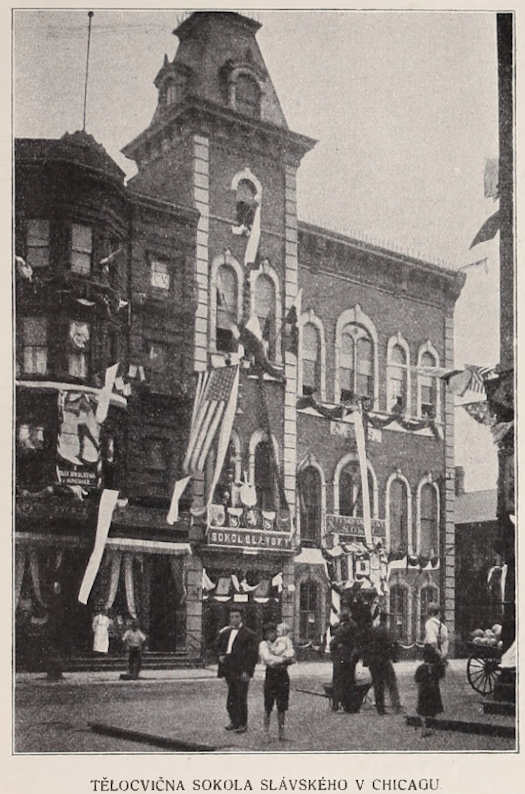
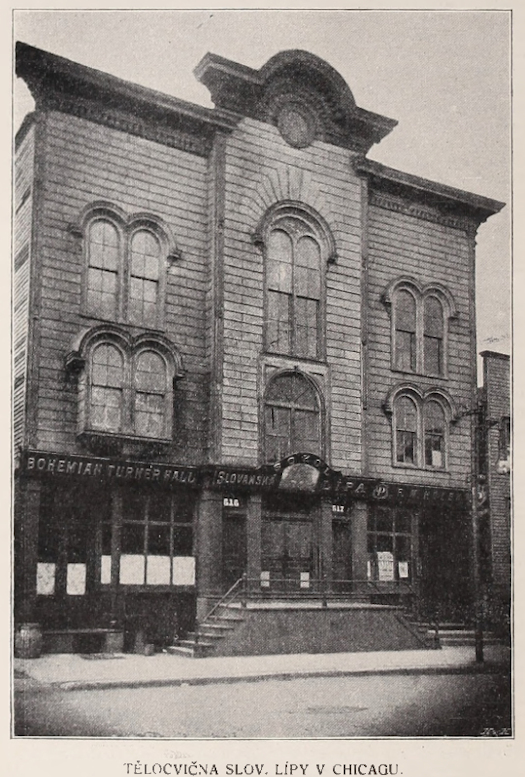
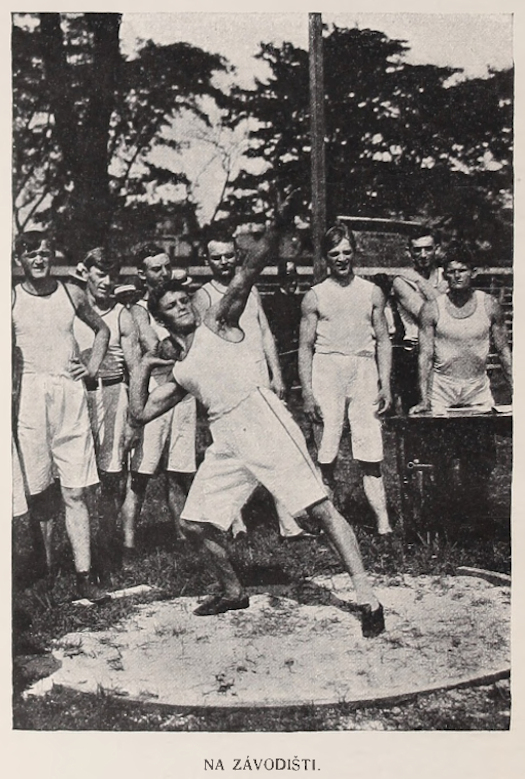
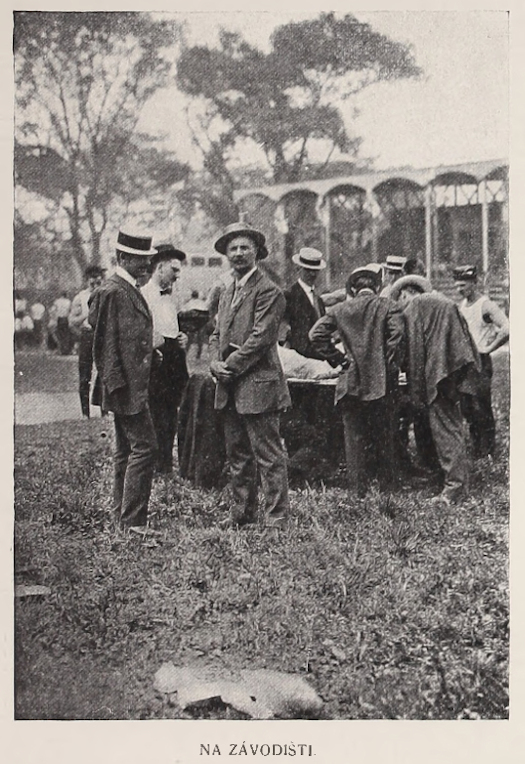
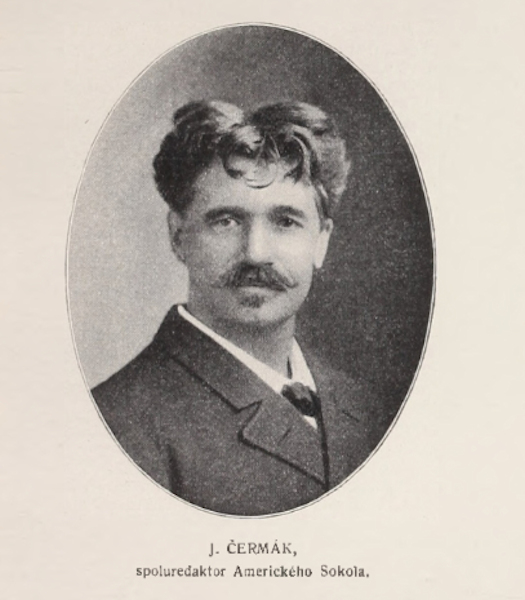
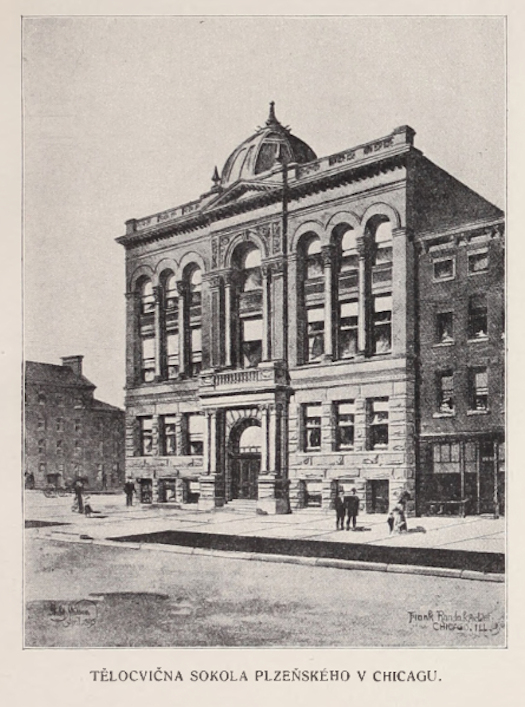






Saving Pilsen’s 100-year-old Sokols, the historic Czech athletic clubs
A historic district could protect two endangered buildings that once defined the Czech neighborhood.
